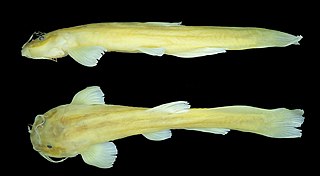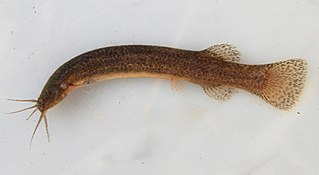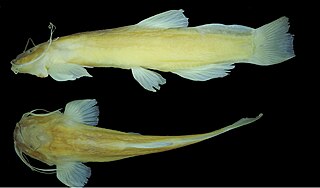
The Amblyopsidae are a fish family commonly referred to as cavefish, blindfish, or swampfish. They are small freshwater fish found in the dark environments of caves, springs and swamps in the eastern half of the United States. Like other troglobites, most amblyopsids exhibit adaptations to these dark environments, including the lack of functional eyes and the absence of pigmentation. More than 200 species of cavefishes are known, but only six of these are in the family Amblyopsidae. One of these, Forbesichthys agassizii, spends time both underground and aboveground. A seventh species in this family, Chologaster cornuta, is not a cave-dweller but lives in aboveground swamps.

Trichomycteridae is a family of catfishes commonly known as pencil catfishes or parasitic catfishes. This family includes the candiru fish, feared by some people for its alleged habit of entering into the urethra of humans. They are one of the few parasitic chordates. Another species is the life monsefuano which was important to the Moche culture and still an important part of Peruvian cuisine.
Listrura is a genus of pencil catfishes native to South America.

The Heptapteridae, or three-barbeled catfishes, are a family of catfish that originate from the Americas. Most species are restricted to South America, but Imparfinis lineatus, Nemuroglanis panamensis and Pimelodella chagresi are native to Panama, and Rhamdia species occur as far north as Mexico. The name Heptapteridae is derived from Greek, hepta meaning seven and pteron meaning fin.

Phreatobius is a genus of very small catfishes from tropical South America.

Copionodon is a genus of catfishes of the family Trichomycteridae. It includes three species, C. lianae, C. orthiocarinatus, and C. pecten.
Glanapteryx is a genus of catfishes native to South America.
Pseudostegophilus is a genus of pencil catfishes native to rivers in tropical South America. The members of this genus are obligate parasites that feed on scales and mucus of other fish.

Ituglanis is a genus of small freshwater fish in the family Trichomycteridae native to South America. Their greatest diversity seems to occur in the Amazon River basin. Most species inhabit leaf litter, with several species living in caves.

Pimelodella kronei is a species of three-barbeled catfish endemic to Brazil. Discovered by the German naturalist Sigismund Ernst Richard Krone, it was the first troglobitic fish described in Brazil, but several others have been described later.
Stygichthys typhlops, the blind tetra or Brazilian blind characid, is a species of fish in the family Characidae and the only member of the genus Stygichthys. It is endemic to caves in northern Minas Gerais, Brazil. Like other cave-adapted fish, the Brazilian blind characid is blind and lacks pigmentation. It reaches up to about 4.6 cm (1.8 in) in standard length. It is solitary and when kept together in an aquarium, individuals are indifferent to each other.
Aspidoras depinnai is a species of catfish from the Ipojuca River basin of Brazil. It belongs to the subfamily Corydoradinae of the family Callichthyidae. It grows to a length of 3.3 cm. The corydora group of fish is varies massively and as a result many fish are hard to differentiate and define. There are no known procedures to follow for aquaria based breeding, but as with all cordora fish they tend to breed after heavy rainfall or when there is a drop in water temperatures or hardness.

Cavefish or cave fish is a generic term for fresh and brackish water fish adapted to life in caves and other underground habitats. Related terms are subterranean fish, troglomorphic fish, troglobitic fish, stygobitic fish, phreatic fish, and hypogean fish.
Glaphyropoma rodriguesi is a species of pencil catfish endemic to Brazil. This species grows to a length of 5.1 centimetres (2.0 in) SL.
Nannoplecostomus eleonorae is a species of armored catfish known only from the upper Rio Tocantins basin in the Brazilian state of Goiás. This species grows to a length of 2.22 centimetres (0.87 in) SL. This species is the only known member of its genus and the smallest loricariid catfish known.

Glaphyropoma spinosum is a species of pencil catfish found in the regions of Chapada Diamantina, Município de Andaraí, Povoado de Igatu, Gruna dos Torras, Rio Paraguaçu in Bahia, Brazil. This species reaches a length of 5.8 cm (2.3 in).

Copionodon pecten is a species of catfishes of the family Trichomycteridae. It is found in the Mucujê River, a tributary of Paraguaçu River in Bahia, Brazil. This species reaches a length of 6.2 cm (2.4 in).
Copionodon orthiocarinatus is a species of catfish of the family Trichomycteridae. It is found in the Mucujê River, a tributary of Paraguaçu River in Bahia, Brazil. This species reaches a length of 7.5 cm (3.0 in).
Copionodon lianae is a species of catfishes of the family Trichomycteridae. It is found in the Grisante River, a tributary of the Mucujê River, which is a tributary of the Paraguaçu River in Bahia, Brazil. This species reaches a length of 6.2 cm (2.4 in).
Pareiorhaphis lophia is a species of catfish in the family Loricariidae. It is native to South America, where it occurs in the Paraguaçu River basin in Brazil. It is typically found in shallow rocky stretches of coastal blackwater rivers, including rapids. It is known to be syntopic with Hypostomus chrysostiktos and Hypostomus jaguar. The species reaches 8.2 cm in standard length and is believed to be a facultative air-breather.









